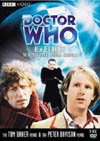Logopolis
 |
 |
 |
DVD NTSC
1-story disc
Region 1




for North America
|
DVD PAL
3-story box set
Region 2


for the U.K.
|
VHS Video
NTSC


PAL


|
|
(Doctor Who Story No. 116, starring Tom Baker)
- written by Christopher H. Bidmead
- directed by Peter Grimwade
- produced by John Nathan-Turner
- music by Paddy Kingsland
- 4 episodes @ 25 minutes each
|
Story: Developing plot-lines from
season 18 are brought to a close. An attempt
to repair the TARDIS's chameleon circuit and
"run a tighter ship" brings the Doctor and Adric into
another deadly encounter with the Master, as the action
moves between England and a clerical society on the
planet Logopolis that lives and breathes computations.
Janet Fielding debuts as Tegan Jovanka, and Nyssa returns
to round out the emerging TARDIS crew. Tom Baker gives
his unforgettable final performance as the Doctor.
|
|
 |
New Beginnings
3 DVD boxed set
NTSC Region 1




for North America
|
|
DVD Extras include:
- Audio commentary by actors Tom Baker (The Doctor)
and Janet Fielding (Tegan),
and writer Christopher H. Bidmead.
- "A New Body at Last" 50 minute documentary on the making
of Logopolis and the transition from Tom Baker
to Peter Davison,
with Tom Baker, Chris Bidmead,
Sarah Sutton (Nyssa),
Matthew Waterhouse (Adric),
Adrian Gibbs (The Watcher),
Peter Davison (the next Doctor), and
series directors Peter Moffatt and John Black.
- "Nationwide" interviews with Tom Baker & Peter Davison (8 min.)
- "Pebble Mill at One" Peter Davison interview (12 min.)
- BBC News Reports on Tom Baker's wedding & departure,
and Peter Davison's arrival (1 min.)
- Isolated Music Score by Paddy Kingsland
- Pop-up Production Note Subtitles
- Photo Gallery music montage (5 min.)
- DVD ROM .pdf files: 1982 Dr. Who Annual, Radio Times,
& BBC Enterprises literature
In-Depth Analysis Review
by Martin Izsak
|
|
WARNING: This review contains "SPOILERS", and is intended for
those who have
already seen the program. To avoid the spoilers,
read the Buyers' Guide version instead.
|
Season Eighteen goes out with a very satisfying bang, albeit
perhaps one less accessible to casual viewers of the show. Written
by this season's script editor, Christopher Hamilton Bidmead,
"Logopolis" draws on the threads of earlier stories from the season
and knits a compelling tapestry of the Doctor's universe.
The introductions opening this story really don't seem designed
for new or casual viewers. Whether you assume the police box by
the road is the infamous TARDIS or just an ordinary telephone device,
the effect playing out on it is far from self explanatory, and most
likely forgotten by the time some clues slip through a later dialogue
scene. Once again, the sound effect is your best clue to what is
happening in this sequence, if you're versed enough with the show
to recognize it as not the Doctor's but the Master's TARDIS
materializing.
And why does the Master bother harming the policeman? It doesn't
really fit in with the rest of his plans; it just fulfills one of
the needs of script structure.
The actual TARDIS itself is presented from the inside out during
this opening, starting so deep inside that even regular viewers may
have to make an effort to recognize where the Doctor and Adric's
first scene is taking place. All in all, not a bad scene, nicely
introducing the entropy theme that becomes central to the story.
The cut back to Earth to introduce Tegan and her Aunt is also
nicely set up.
Bidmead's noble aim of bringing out Adric's enquiring mind
doesn't really seem on the surface to be doing anything more than
fulfilling one of the primary traditional roles of the Doctor's
companion: to ask questions about the plot for the audience. Many
times in this story, it seems a parrot could have done the job better.
Adric's unfamiliarity, and subsequent endless bland questioning,
of Earth culture begins to slow the story down, demonstrating that
it is a mistake to allow the companion to fall far behind the
audience. Without a stronger line of humour, its entertainment
value is seriously questionable.
A more serious problem is at
its absolute worst in the Doctor and Adric's second scene in the
cloister room, where Bidmead's thought patterns with their strong
mis-matching tendencies are allowed to produce a line of questioning
for Adric that takes us farther from the ideas Bidmead is trying to get
across instead of closer. Added clarity this is not! Bob Baker and
Dave Martin often got hung up like this on previous scripts. As
a mis-matcher, Bidmead will probably be expert at correcting himself
once he realizes this method is not to anyone's advantage.
Tom Baker adds extra solemness and foreboding to his portrayal
of the Doctor, which is a wonderful touch for this particular story.
The mysterious Watcher character is also a very successful element
adding to the emotional weight of the piece, which Tom is able to
play off of brilliantly. It's also a very unusual element for a
Doctor Who story, helping to keep the narrative fresh.
The sequence of Tom peering out of the TARDIS door in episode one
is very good for establishing some clarity about the TARDIS for
new viewers, as is the TARDIS landing beside the police box before
surrounding it, and all the dialogue surrounding the view from the
scanner screen. Indeed, it's hard to imagine anyone coming to the
end of the story "Logopolis" without knowing far more about what the
vehicle is and how it works than they may ever need to know.
Motivating the Master
The Master's main ambitions work well in this story, and are
particularly well-anchored to his character flaws. Digging deeper
to look at the details of some of his more minor actions, however,
enough holes appear to rank this as the least successful of Tom
Baker's three excellent Master stories.
All the best Master motivations are in play: He is still regaining
what he had before, getting used to the new body he has just acquired.
He has a grand ambition, to discover the secret work taking place
on Logopolis and develop a plan to use it to his personal advantage,
although even he cannot fully anticipate how grand the scope of
this will become. Thirdly, his vengeful sparring with the Doctor
also continues on the side, where it belongs.
The Master's final scheme in this story really emphasizes his
lack of having defined a clear lifestyle of choice for himself, as
the self-centered loner trying to command the entire universe with
absolutely no supporting social structure between it and himself.
What would characters be without issues and flaws? Here's the Master's
biggest issue, laid out more clearly here than anywhere else.
Episodes one and two are particularly strange, in that the Master's
presence is entirely represented by his TARDIS and the occasional
voice-over evil laugh. This is also where his motivations are most
difficult to recognize. Tom's Doctor fills in many of the details,
but what is the overarching logic? Why does he need to hide his
TARDIS inside the Doctor's to get to Logopolis? Is the location some
secret that only the Doctor knows? If so, the script would be much
better off for saying so.
Obviously, the ordinary police box is inside the Master's TARDIS
when the Doctor's materializes around them both, but what is going
on after that? The Doctor and Adric appear to have made their way
into the Master's console room, when somehow the Master should be
at the controls causing the dematerialization that Tegan nearly
witnesses as she makes her way into the Doctor's console room.
And then, without having re-materialized anywhere, the Master is
suddenly in the door of the Doctor's TARDIS causing Auntie Vanessa's
end for no apparent good reason.
And what exactly is the phenomenon that the Doctor and Adric
investigate, with its endless succession of darker and darker console
rooms? Actually it does end, having only been three console rooms
including the Doctor's own regular one. The term "gravity bubble"
turns up, which may refer to nothing more than the artificial emotional
gravity that the phenomenon is able to provide the story, once
Tom Baker's delivery of the lines that support it have worked their
magic.
And where does the ordinary police box go during all this? One
assumes it is still inside the Master's TARDIS when it dematerializes
from the Doctor's console room. So how is it put back in place when
the Doctor dematerializes?
The excessive but enjoyable shenanigans of the Master's TARDIS
finally reach a high point when its ever-changing disguise becomes
that of a Greek pillar - the most definitive and widely used form
his TARDIS has ever taken on the program, making its debut here
in Logopolis. Right on!
The Master's weapon of choice, the Tissue Compression Eliminator,
also returns in this story. Having only appeared briefly in
Robert Holmes' Master stories
"Terror of the Autons" (story no. 55) and
"The Deadly Assassin" (story no. 88),
it now becomes a much more staple device for Anthony
Ainley's era as the Master. As before, it is demonstrated more
through evidence of its effect on its victims than with any satisfying
visual beam effects. A bit disappointing, but directed well enough
in spite of this.
Logopolis itself is an interesting idea of a place, brought well
enough to the screen. There is a certain lack of entertaining social
complexity amongst the inhabitants, and the sets seem to have been
designed for the ability to crumble on cue rather than any real
aesthetic value, so it does seem advantageous that the screen time
spent there is only one full episode plus two halves.
With only John Fraser's compellingly dignified performance to
represent the entire Logopolitan guest roster, the focus of the
story remains on the growing regular cast. Nyssa's re-entrance
to the series late in episode two seems like a very arbitrary
last-minute addition, but from episode three on she becomes an
essential part of the story, especially helping to establish
Anthony Ainley in his new role and believably bring his character
out of his long drawn-out gestation in the shadows. Episodes three
and four finally allow Ainley to put his stamp on the recurring role
he will be most remembered for on Doctor Who, making the Master into
a worthy and enjoyable adversary for the adventures of my favourite
Doctors. Excellent.
Janet Fielding also debuts as Tegan Jovanka, naively
over-projecting her performance in a manner more appropriate for
the stage than the small screen. Having become accustomed to
her character throughout her more experienced portrayals in
season 19 before seeing this story for the first time, I was
perfectly willing to accept her character in this tale.
It is interesting to note how the plot and the action have
deviated from the traditional monster-story formulae laid out
in the Troughton
and Pertwee eras,
embracing more of the sci-fi
mystery story beats made popular by Robert Holmes, Douglas Adams,
and Bob Baker and Dave Martin during
Tom Baker's era, and in the
case of this particular story and its fascination with TARDISes,
producing an action plot that is uniquely Whovian. Even if it is
less accessible to the masses, and a bit slower than would be
ideal in the first half of the story, it has the power to captivate
regular viewers of the show and deliver a sci-fi mystery of mythological
impact to the show.
The entropy theme also nicely mirrors the idea of this being the
end of Tom's era, and both ideas are developed with appropriate
emotional gravity.
Throughout the final episode, the Doctor and the Master share
credit for many heroic ideas, some used and some not, while still
allowing their methods and characters to clash interestingly. During
the finale, however, the three companions are clearly relegated to
clarifying things for the audience and providing perspective, while
the Master shifts over to villainy, leaving the final heroics to the
Doctor alone - nicely satisfying the traditions of the best hero myths.
Although more time and money might have resulted in
improved blocking and effects, not to mention extra takes, director
Peter Grimwade maximizes his editing choices and gets great emotional
value from his footage, not to mention the extra boost from JNT's
flashback ideas, making Tom Baker's finish possibly the best any
Doctor has ever had. (That said, Patrick Troughton's
"The War Games" [story no. 50]
still takes the cake for best final story, in my view.)
The mystery of exactly who and what the Watcher is doesn't seem
to get answered satisfactorily at any point in this story, or the next
one for that matter. For many years, this was the only regeneration
I had witnessed on Doctor Who, and it left me falsely assuming that
the process could only happen when some husk of material wandered
in from Gallifrey and caught up with the Timelord who needed the
regeneration,
providing much of the required extra raw energy, among other things.
Bidmead has his own ideas about what was happening, elaborated on
in the recent commentary for the story on DVD and deliberately left
vague in the story for reasons that have some merit.
But for me the definitive explanation for the Watcher comes from
"Planet of the Spiders" (story no. 74),
where it's made clear that Kan'Po Rinpoche's
next Timelord incarnation is wandering around on its own prior
to regeneration. At least Kan'Po knew what he was doing. Tom Baker's
Doctor seems to have created the projection of his new self
unconsciously, allowing it to pop up unexpectedly and spook himself.
Typical. Of all the Doctors, Tom's is the king of being spooked and
haunted. How could he not go out any other way?
Much of the mood of the story must be credited to Paddy Kingsland's
very versatile and thematic score. One of his very best ever, it is
surprising to note how much of it is composed of short little stings
and stabs, with only a few cues of decent length. Themes for Logopolis
and the Watcher are excellent, as is a three-note motif for the Master
that develops into a more definitive five notes by the third episode
and carries over into
the next story. A variety of lively action cues and some darker
ominous pieces complete a lovely emotional range for the score. And
the nice bit of Schubert's Unfinished Symphony in the final episode
is also an enjoyable touch. Well done.
In the end, Logopolis is one of the best Doctor Who stories,
if a little unusual, ranking only slightly behind
"The Keeper of Traken" (story no. 115)
for season eighteen, and having a more emotionally satisfying conclusion
to boot. It is certainly not to be missed by anyone
seeking to go through the mythological highlights of the series.
International Titles:
Deutsch: "Logopolis"
Magyar: "Logopolis"
Français: (Logopolis)
Русский: "Логополис"
Season Eighteen Rankings:
Best Story:
- The Keeper of Traken
- Logopolis
- State of Decay
- Full Circle
- The Leisure Hive
- Meglos
- Warriors' Gate
Best Writer:
- Johnny Byrne
- Christopher H. Bidmead
- Terrance Dicks
- Andrew Smith
- David Fisher
- John Flanagan & Andrew McCulloch
- Stephen Gallagher
Best Director:
- Peter Grimwade
- John Black
- Peter Moffatt
- Terence Dudley
- Lovett Bickford
- Paul Joyce
|
|
Best Music:
- Meglos (Howell/Kingsland)
- Warriors' Gate (Peter Howell)
- Logopolis (Paddy Kingsland)
- State of Decay (Paddy Kingsland)
- Full Circle (Paddy Kingsland)
- The Leisure Hive (Peter Howell)
- The Keeper of Traken (Roger Limb)
Best Lasers & Other Electronic Effects:
- The Keeper of Traken
- State of Decay
- Meglos
- Warriors' Gate
- Logopolis
- Full Circle
- The Leisure Hive
|
Logopolis has become available on DVD and VHS video.
Single Story versions:
 |
 |
 |
DVD NTSC Region 1
for the North American market:

 in the U.S.
in the U.S.

 in Canada
in Canada
|
DVD PAL Region 2
for the U.K.:
See boxed set below.
|
VHS Video
NTSC

 in the U.S.
in the U.S.
PAL

 for the U.K.
for the U.K.
|
3-story boxed sets:
(Story Nos. 115-117: The Keeper of Traken,
Logopolis & Castrovalva.) |
 |
 |
New Beginnings
3 DVD boxed set
NTSC Region 1

 in the U.S.
in the U.S.

 in Canada
in Canada
|
New Beginnings
3 DVD boxed set
PAL Region 2

 for the U.K.
for the U.K.
|
|
Comments on this article are welcome. You may contact
the author from this page:
Contact page

LYRATEK.COM
|
Read the In-depth Analysis Review for the next story:
"Castrovalva"

|
|









